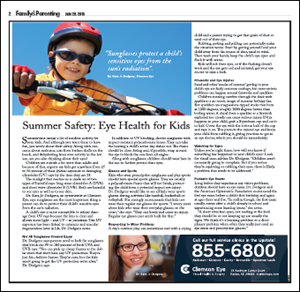Posted by: Clemson Eye in News

Easley Progress Family & Parenting Supplement, July 2015
Summertime means a lot of outdoor activity for your kids. And although you want them to have fun, you worry about their safety. Along with concerns about sunburns, cuts from broken shells on the beach, and dehydrating from over activity in the hot sun, are you also thinking about their eyes?
Children are outside a lot more than adults and because of that, experts say kids get anywhere from 25 to 50 percent of their lifetime exposure to damaging ultraviolet (UV) rays by the time they are 18.
The sunlight that reaches us is made up of two types of harmful rays: long wave ultraviolet A (UVA) and short wave ultraviolet B (UVB). Both are harmful to our eyes as well as to our skin.
Dr. Kara Jo Dodgens, an optometrist at Clemson Eye, says sunglasses are the most important thing a parent can do to protect their child’s sensitive eyes from the sun’s radiation.
A child’s eye is more susceptible to retinal damage from UV rays because the lens is clear and allows more light – and UV – to penetrate. This UV exposure has been linked to cataracts and macular degeneration later in life, Dr. Dodgens notes.
Not All Sunglasses Created Equal
Dr. Dodgens says parents need to look for sunglasses that block out 99 to 100 percent of both UVA and UVB rays. “You can pick up cheap frames at the dollar store that don’t have any UV protection. They’re just fun, fashion frames. They’re cute, but the kids aren’t going to get the UV protection we’re after,” Dr. Dodgens says.
In addition to UV blocking, choose sunglasses with impact-resistant polycarbonate lenses. They can take the beating a child’s active day dishes out. The frame should be close fitting and, if possible, wrap around the eye to block the sun from all angles.
Along with sunglasses, children should wear hats in the sun to further protect their eyes.
Glasses and Sports
Kids who wear prescription eyeglasses and play sports should have special sports glasses. They are usually a polycarbonate frame that will not break, protecting the child from a potential impact eye injury. Dr. Dodgens would like to see all kids wear sports glasses during activities like baseball, basketball or volleyball. She strongly recommends that kids not wear their regular eye glasses for sports. “I worry more about kids who wear their everyday glasses on the court,” she says. “They can break and cause an injury. Regular eye glasses just aren’t built for that.”
Responding to Minor Problems
A day’s outdoor play can sometimes end with a crying child and a parent trying to get that grain dust or sand out of their eye.
Rubbing, poking and pulling can potentially make the situation worse. Start by getting yourself and your child away from the source of dust, sand or wind. Then wash your hands, keep the child’s eye open and flush it with water.
Kids will rub their eyes, so if the flushing doesn’t work and the eye gets red and irritated, get your eye doctor to take a look.
Fireworks and Eye Injuries
Sand and other ‘specks of summer’ getting in your child’s eye are fairly common mishaps, but more serious problems can happen around fireworks and sparklers.
Children running carefree through the dusk with sparklers is an iconic image of summer holiday fun. But sparklers are magnesium-tipped sticks that burn at 1200 degrees, roughly 1000 degrees hotter than boiling water. A shard from a sparkler or a firework exploded too closely can cause serious injury. If this happens to your child, grab a Styrofoam cup and cut it in half. Cover the eye with the bottom half of the cup and tape it on. This protects the injured eye and keeps your child from rubbing it, giving you time to get to an eye doctor, which you should do immediately.
Watching for Signs
Unless you’re right there, how will you know if something has happened to your child’s eyes? Look for visual cues, advises Dr. Dodgens. “Children aren’t necessarily going to complain. But if you notice they’re squinting or rubbing their eyes, there is likely a problem that needs to be addressed.”
Pediatric Eye Exams
Long before they experience any vision problems, children should have an eye exam. Dr. Dodgens and the American Optometric Association recommend the first eye exam before a child’s first birthday, and again at ages three and five. “In reality, though, the first exam usually comes after a child’s already in school and experiencing some learning issues,” she notes.
“A short attention span, not reading at the level they should be or not keeping up are usually the signs. We think it’s a learning problem or a disciplinary problem when often they really just need an eye exam and prescription glasses.”